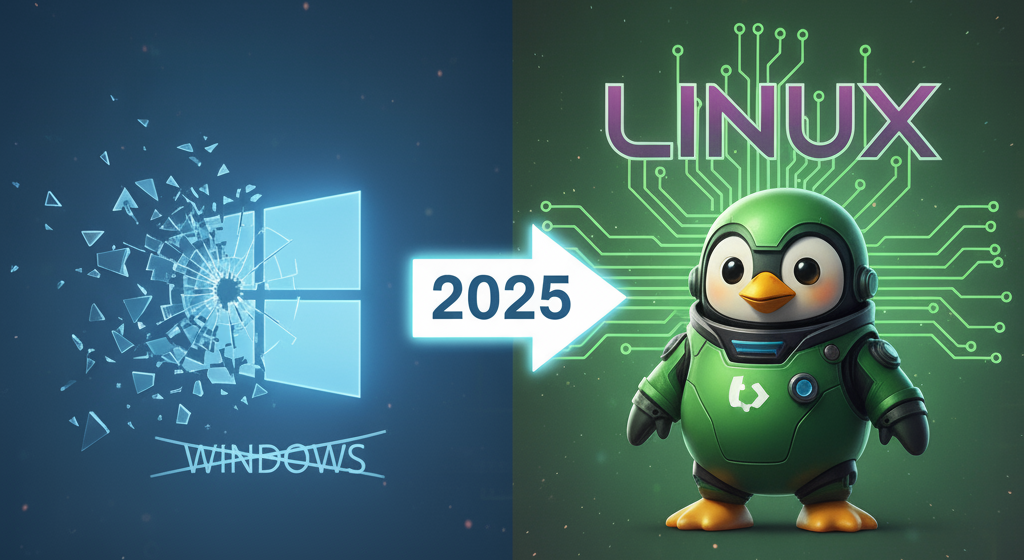The journey to select the perfect web browser on a Linux system is a quintessential reflection of the Linux philosophy itself: unparalleled freedom, profound customization, and absolute user control. Unlike the more constrained ecosystems of Windows and macOS, the landscape of Linux browsers is a vast and varied terrain, offering everything from mainstream powerhouses to minimalist, terminal-based tools. This abundance of choice, however, presents a significant challenge. For both newcomers and seasoned veterans, navigating this ecosystem can be a complex task, with decisions hinging on a delicate balance of performance, privacy, features, and underlying technology.
This guide is designed to serve as the definitive map for that terrain. The following analysis moves beyond simple lists and superficial reviews to provide a comprehensive, expert-level examination of the Linux browser ecosystem in 2025. It will dissect the mainstream champions, explore the niche specialists, and delve into the critical technical details that define the user experience on Linux. This report will equip every user—from the curious beginner installing their first distribution to the power user managing hundreds of tabs, and the developer automating web tasks—with the deep, nuanced understanding required to make a truly informed decision. We will explore the fundamental trade-offs between rendering engines, the practical steps to unlock hardware-accelerated performance, the security implications of modern installation methods, and the specific tools that cater to every conceivable workflow.
The Mainstream Champions: A Head-to-Head Analysis
For the majority of users, the choice of a Linux browser will narrow down to a handful of well-supported, feature-rich applications. These mainstream champions offer a blend of performance, compatibility, and ease of use, but they differ significantly in their philosophies, feature sets, and a user’s control over their own data.
Mozilla Firefox: The Open-Source Standard-Bearer
As the default browser included with many of the most popular Linux distributions, such as Ubuntu, Fedora, and Linux Mint, Mozilla Firefox stands as a pillar of the open-source community and a staunch advocate for a free and open web. Its most significant differentiator in the modern browser landscape is its use of the independently developed Gecko rendering engine. This technical distinction is not merely academic; it represents a crucial bastion of diversity in a market increasingly dominated by a single engine, ensuring that web standards remain open and not dictated by a single corporate entity.
Firefox’s reputation is built on a foundation of strong, user-centric privacy features. Out of the box, its Enhanced Tracking Protection actively blocks a wide array of social media trackers, cross-site cookies, and cryptominers, offering users a level of protection that often requires third-party extensions in other browsers. This commitment to privacy is coupled with an unparalleled capacity for customization. The about:config interface provides granular control over thousands of internal settings, allowing advanced users to fine-tune everything from network behavior to rendering parameters. Furthermore, unique features like Firefox Containers enable users to isolate different aspects of their digital life—such as work, personal, and shopping—into separate, color-coded tabs, preventing websites from tracking activity across these contexts. This combination of strong default privacy and deep, accessible customization makes Firefox the go-to choice for users who prioritize control and support for an open web ecosystem.
Official Website: https://www.mozilla.org/firefox/
Google Chrome & Chromium: The Performance Kings
Google Chrome holds the title of the world’s most popular web browser, a position earned through its reputation for speed, robust performance, and seamless integration with the vast Google ecosystem of services like Gmail, Drive, and Docs. For Linux users, however, the “Chrome” experience is split into two distinct paths: the proprietary Google Chrome and its open-source foundation, Chromium. Understanding the difference between these two is absolutely critical for making an informed choice.
Chrome vs. Chromium – The Critical Trade-Off for Linux Users
The decision between Google Chrome and Chromium revolves around a core trade-off: convenience and compatibility versus privacy and open-source principles.
- Google Chrome is the polished, proprietary product distributed by Google. Its primary advantage lies in its out-of-the-box completeness. It includes licensed, proprietary media codecs like H.264 and AAC, which are essential for the proper functioning of many popular streaming services such as Netflix. It also features a reliable automatic update mechanism that ensures users are always running the latest version with the most recent security patches. This convenience, however, comes at a significant privacy cost. Google Chrome integrates deep tracking and telemetry services that report user data back to Google for purposes of personalization and advertising.
- Chromium is the open-source project that forms the basis for Google Chrome and many other browsers. It is available directly from the software repositories of many Linux distributions, making it easy to install and maintain through standard system updates. Its key appeal is that it provides the raw performance and compatibility of the Blink rendering engine without Google’s proprietary tracking code, making it a superior choice for privacy-conscious users. This choice involves significant compromises. Chromium lacks the licensed media codecs found in Chrome, which means that major streaming sites may fail to play video content without manual user intervention to install the necessary libraries. Furthermore, since updates are managed by distribution maintainers, there can be a delay between the discovery of a security vulnerability and the availability of a patched version in the repositories. Finally, the browser’s security sandbox, a critical feature for isolating web content, may be configured differently by each distribution, potentially altering its effectiveness compared to Google’s official build.
Ultimately, the choice is clear: users who prioritize a seamless, “it just works” experience, especially for media consumption, and are comfortable within the Google ecosystem will gravitate towards Google Chrome. Users who value open-source software and wish to minimize data collection while still benefiting from the Blink engine’s performance will find Chromium to be the more suitable, albeit more demanding, option.
Official Websites: https://www.google.com/chrome/, https://www.chromium.org/
Brave: The Privacy-First Challenger
Brave has carved out a significant niche in the market by positioning itself as a Chromium-based browser fundamentally re-engineered for privacy and security. Its core philosophy is to protect users by default, rather than requiring them to opt-in to privacy features. The central component of this approach is Brave Shields, an aggressive, built-in system that blocks invasive ads, trackers, and third-party cookies the moment the browser is installed. This has a dual benefit: it dramatically enhances user privacy and, by preventing the download and execution of superfluous scripts and ad content, it significantly improves page load times and reduces CPU and memory usage.
Beyond simple ad-blocking, Brave employs more sophisticated privacy-enhancing technologies. It features some of the strongest anti-fingerprinting protections available, which work by randomizing the browser’s digital signature to prevent sites from uniquely identifying and tracking users across the web. Brave also offers an optional and unique system called Brave Rewards. This allows users to opt-in to viewing privacy-respecting advertisements from Brave’s own network. In return for their attention, users earn the Basic Attention Token (BAT), a cryptocurrency that can be tipped to content creators or, in the future, used for other premium services. This model presents an alternative to the pervasive ad-tracking economy, attempting to create a more equitable system for users, advertisers, and publishers. For Linux users seeking maximum privacy with the speed and compatibility of a Chromium base, Brave presents a compelling, out-of-the-box solution.
Official Website: https://brave.com/
Vivaldi: The Power User’s Dream
Vivaldi is the direct spiritual successor to the classic, pre-Chromium versions of Opera, built by a team led by Opera’s co-founder, Jon von Tetzchner. It unabashedly targets power users, developers, and anyone who feels constrained by the minimalist design of modern browsers. Its mission is to provide the most customizable and feature-rich browsing experience on the market, giving users complete control over their workflow.
Vivaldi’s feature set is exceptionally deep and designed to eliminate the need for dozens of third-party extensions. Its standout capabilities include:
- Extreme Customizability: Vivaldi allows users to modify nearly every aspect of the user interface. Toolbars, address bars, and panels can be moved, resized, and re-colored, allowing for a truly personal browser layout.
- Advanced Tab Management: This is Vivaldi’s signature strength. Tab Stacking lets users group related tabs into a single, two-level stack. Tab Tiling allows for a split-screen view of multiple web pages within a single browser window. Workspaces provide a way to organize entire sets of tabs into distinct categories, such as “Work,” “Research,” or “Personal,” which can be switched between instantly.
- Integrated Productivity Suite: Vivaldi includes a full-featured, built-in Mail client, Calendar, and RSS Feed Reader. This “Dashboard” approach consolidates common productivity tools directly into the browser, which can replace standalone applications like Thunderbird for many users.
- Powerful Navigation Tools: Beyond standard shortcuts, Vivaldi offers Mouse Gestures for executing commands with simple mouse movements and Quick Commands, a pop-up command-line interface for searching tabs, history, and settings. Users can even create custom Command Chains to automate complex, multi-step workflows with a single shortcut.
For the Linux user who wants a browser that adapts to them, not the other way around, and who manages complex, multi-tab workflows, Vivaldi is in a class of its own.
Official Website: https://vivaldi.com/
Opera: The Feature-Packed Veteran
As one of the oldest and most recognizable names in web browsing, Opera has evolved significantly since its inception in 1995. Now built on the Chromium engine, it competes by offering a unique suite of built-in features designed for convenience and enhanced functionality. Unlike browsers that prioritize minimalism, Opera aims to provide a rich, all-in-one experience straight out of the box.
Its most prominent feature is a free, built-in browser VPN, which, while not a replacement for a full-fledged paid VPN service, offers a simple way to obscure one’s IP address and enhance privacy on public Wi-Fi networks. Opera also includes an effective ad-blocker and a “Turbo” mode designed to compress data and speed up browsing on slow or metered internet connections. A key element of its user interface is the sidebar, which provides quick access to integrated social media messengers like WhatsApp, Facebook Messenger, and Instagram, allowing users to chat without switching windows or applications. For users who appreciate these integrated conveniences and want a browser that comes fully equipped without the need for additional extensions, Opera remains a relevant and feature-packed choice on Linux.
Official Website: https://www.opera.com/
The Engine Room: Why Blink vs. Gecko Matters on Linux
The choice between Linux browsers extends far beyond surface-level features like tab management or built-in VPNs. At its core, it is a decision that engages with the fundamental architecture of the modern web. Today, the browser market is dominated by two primary rendering engines: Blink, the Google-led engine that powers Chrome, Brave, Vivaldi, Opera, and Edge, and Gecko, the Mozilla-developed engine that powers Firefox. This is not merely a technical rivalry; the near-monopoly of one engine has profound consequences for web standards, developer practices, and ultimately, the user experience.
The Blink Monoculture and Its Consequences
The Blink engine’s overwhelming market share, currently used by well over two-thirds of all internet users, has created a dangerous feedback loop often referred to as a “browser monoculture”. With the majority of users on a Blink-based browser, many web developers now build and test their sites primarily, or even exclusively, for this engine. This can lead to a frustrating experience for users of Gecko-based browsers like Firefox. Websites may render incorrectly, features may be broken, or performance may be significantly degraded—not because of any inherent flaw in Gecko, but because the site was never properly tested on it. This situation risks cementing Blink as a de facto web standard, ceding enormous control over the future of the internet to a single corporation and undermining the open, collaborative process that has historically defined the web.
Technical and Philosophical Differences
While both are highly advanced pieces of software, the two engines have different priorities and architectural philosophies that manifest in several key areas:
- Performance: In synthetic benchmarks, Blink’s V8 JavaScript engine often shows a performance advantage over Firefox’s SpiderMonkey, particularly in computationally intensive web applications. This can translate to a snappier feel on complex sites. However, real-world performance is far more nuanced. For many common browsing tasks, the speed difference is negligible, and some benchmarks have shown Firefox to outperform Chrome in specific sub-tests related to graphics and rendering.
- Resource Usage: The perception of resource usage is complex. Forum discussions sometimes suggest that Gecko can be more memory-intensive on certain websites. However, this is highly dependent on the number of open tabs, the extensions in use, and whether features like hardware acceleration are properly configured. A heavily-extended Chromium browser can easily consume more resources than a lean Firefox installation.
- Security: Both Mozilla and Google employ world-class security teams dedicated to finding and patching vulnerabilities. Both engines are incredibly secure, but they have different architectural approaches to sandboxing and process isolation, leading to different types of vulnerabilities being discovered over time. Neither has a permanent, definitive advantage over the other.
Ultimately, the choice of engine is as much philosophical as it is technical. Opting for a Blink-based browser offers the path of least resistance, ensuring maximum compatibility with a web that is increasingly built for it. Choosing a Gecko-based browser like Firefox, however, is an active vote for web diversity. It helps ensure that more than one implementation of web standards remains viable, which is critical for the long-term health, openness, and resilience of the internet.
Specialized Tools for the Job: Finding Your Niche Browser
Beyond the mainstream contenders lies a vibrant ecosystem of specialized Linux browsers, each designed to excel at a specific task or serve a particular user philosophy. These browsers often trade broad, all-purpose functionality for excellence in a chosen domain, be it uncompromising privacy, extreme efficiency on older hardware, or a purely text-based interface.
Privacy Goes First
For users whose primary concern is shielding their digital footprint from surveillance and tracking, several browsers offer protections that go far beyond the defaults of their mainstream counterparts.
- LibreWolf: This browser is best understood as a community-driven, hardened fork of Firefox, meticulously configured for maximum privacy and security. LibreWolf’s developers systematically strip out all telemetry, data collection, and “phoning home” features present in standard Firefox, including Pocket integration and sponsored content recommendations. It ships with the powerful ad and tracker blocker uBlock Origin pre-installed and defaults to privacy-respecting search engines like DuckDuckGo and Searx. Its goal is to provide the highest level of privacy possible without completely breaking web compatibility, though its aggressive settings can occasionally cause issues on some sites. For the user who would spend hours tweaking Firefox’s about:config for privacy, LibreWolf provides that hardened state right out of the box.
Official Website: https://librewolf.net/ - Tor Browser: While other browsers focus on privacy, the Tor Browser’s singular goal is anonymity. It achieves this by routing all web traffic through the volunteer-operated Tor network, a series of encrypted relays that make it extremely difficult to trace the user’s location and identity. Based on a modified version of Firefox’s Extended Support Release (ESR), it includes numerous patches and configuration changes to block common tracking techniques and prevent IP address leaks. This robust protection makes it the essential tool for journalists, activists, and anyone needing to circumvent censorship or surveillance. The trade-off is a significant reduction in browsing speed, making it impractical for everyday use but indispensable when true anonymity is required.
Official Website: https://www.torproject.org/
For the Minimalist & Low-Spec Warrior
Running Linux on older hardware or preferring a lightweight desktop environment calls for a browser that sips, rather than gulps, system resources. While optimizing a mainstream browser is often the best first step, several dedicated lightweight options exist.
- Falkon: Originating from the KDE project, Falkon is a lightweight browser built with the Qt toolkit, ensuring seamless visual integration with the KDE Plasma desktop. It uses the QtWebEngine, which is based on Blink, giving it good compatibility with the modern web. However, its lightweight nature comes with major caveats. Falkon lacks support for the vast ecosystem of Chrome and Firefox extensions, which is a deal-breaker for many users. Its built-in ad blocker is less powerful than alternatives like uBlock Origin, and user reports frequently mention usability glitches and stability issues that make it a challenging choice for a daily driver.
Official Website: https://www.falkon.org/ - GNOME Web (Epiphany): As its name suggests, GNOME Web is the minimalist browser designed for the GNOME desktop. It uses the WebKitGTK engine (the same family as Apple’s Safari) and features a clean, uncluttered interface, a default ad-blocker, and the convenient ability to sync bookmarks and passwords with a Firefox account. While it is designed to be lightweight, its real-world performance is a point of significant controversy. Numerous user reports and bug tracker entries describe severe memory leaks, where the browser can consume multiple gigabytes of RAM with only a few tabs open, making it paradoxically heavier than mainstream alternatives.
Official Website: https://wiki.gnome.org/Apps/Web - Midori: Midori has a long history as a classic lightweight browser. In its modern incarnation, it has been re-engineered and is now based on Firefox, aiming to provide a faster, more resource-efficient experience by stripping out potential bloat while retaining compatibility with Firefox’s powerful extension ecosystem. It includes a built-in ad blocker and offers an optional VPN service. While performance is generally praised, some users have raised concerns about trust due to its promotion of the proprietary AstianGO search engine and its removal from the official repositories of some major distributions like Debian.
Official Website: https://astian.org/midori-browser/
For the Terminal Titan
For many system administrators, developers, and command-line purists, the graphical user interface is an unnecessary overhead. Terminal-based browsers offer an extremely fast, resource-efficient, and distraction-free way to access web information directly from the console.
- Lynx: As the oldest web browser still in active development, Lynx is a living piece of internet history. It is a purely text-based browser, rendering web pages without any CSS, JavaScript, or images. This makes it incredibly fast and perfect for reading articles or documentation in a low-bandwidth SSH session or for users who rely on text-to-speech technologies. Its simple, keyboard-driven navigation allows for rapid access to information without the distractions of the modern graphical web.
Official Website: https://lynx.invisible-island.net/ - w3m: Often considered a step up from Lynx, w3m offers a more advanced terminal browsing experience. While still text-based, it can correctly render tables and frames, which are common stumbling blocks for other terminal browsers. Its most notable feature is the ability to display images directly within the terminal using an optional companion package (w3m-img). With support for tabbed browsing and vi-like keybindings for navigation, w3m is a favorite among developers and advanced users who want a richer web experience without leaving the command line.
Official Website: https://w3m.sourceforge.net/
Performance Deep Dive: Optimizing Your Browsing Experience on Linux
A browser’s performance on Linux is not a fixed attribute but a dynamic outcome of its configuration. Users frequently report issues like sluggishness, high CPU usage, and poor battery life, particularly with video playback. These problems are often not inherent flaws of the browser itself but symptoms of a system that is not correctly configured to leverage modern Linux technologies. A “slow” browser can often be transformed into a high-performance tool with a few critical adjustments. This section provides an expert guide to diagnosing and fixing common performance bottlenecks.
The Resource Equation: RAM, CPU, and Battery Life
Analyzing browser performance requires looking at three interconnected resources: memory (RAM), processing power (CPU), and, on laptops, battery consumption.
- RAM Usage: Chromium-based browsers employ a multi-process architecture where each tab and extension runs as a separate process. This enhances stability—a single crashing tab won’t bring down the whole browser—but it often leads to higher overall RAM consumption compared to Firefox, especially with many tabs open. However, real-world tests show a complex picture. Some user benchmarks on Linux indicate that a lean Brave or Chromium installation can use less RAM than Firefox with a few tabs open, while others show Firefox to be more efficient under heavy load. The key variable is often the number and type of extensions being used.
- CPU and Battery Life: This is where the most significant performance differences on Linux often appear. Out of the box, Firefox has historically been reported to consume more CPU power during video playback on Linux compared to Chromium-based browsers. This is not due to an inefficient engine, but typically because it fails to engage the GPU for video decoding. High CPU usage directly translates to increased power consumption, leading to shorter battery life on laptops—a difference that can amount to hours of runtime. The single most effective way to improve CPU and battery performance for any browser on Linux is to ensure hardware video acceleration is enabled and working correctly.
Unlocking Smooth Video: A Practical Guide to Hardware Acceleration (VA-API)
Hardware video acceleration (HVA) is the process of offloading the task of decoding video from the CPU to the dedicated hardware on the Graphics Processing Unit (GPU). This is the standard practice on Windows and macOS, but on Linux, it often requires manual configuration. Enabling it via the Video Acceleration API (VA-API) is critical for achieving smooth, high-resolution video playback while minimizing CPU usage and maximizing battery life.
Enabling HVA in Firefox
For many modern Linux distributions and AMD GPUs, Firefox is beginning to enable VA-API by default. However, for many users, especially those with NVIDIA or older Intel hardware, manual steps are necessary.
- Open
about:config: Typeabout:configinto the Firefox address bar and accept the warning. - Enable VA-API: Search for the preference
media.ffmpeg.vaapi.enabledand double-click it to set its value totrue. - For NVIDIA Users: Proprietary NVIDIA drivers do not support VA-API directly. You must install a compatibility layer,
nvidia-vaapi-driver, which is available in some third-party repositories like RPM Fusion. You may also need to force-enable decoding by settingmedia.hardware-video-decoding.force-enabledtotrueinabout:config. - Install Codecs: Ensure you have the necessary video codecs installed. For H.264 support on Fedora, this involves installing packages like
libavcodec-freeworldfrom RPM Fusion. On Ubuntu-based systems, installing theubuntu-restricted-extraspackage can provide these.
Enabling HVA in Chromium-Based Browsers
Enabling hardware acceleration in Chrome, Brave, Vivaldi, and other Chromium-based browsers is typically done via command-line flags. The exact flags required have changed over time and can vary by GPU vendor and browser version, which adds a layer of complexity.
- Launch with Flags: You must launch the browser from the terminal or edit its
.desktoplauncher file to include specific flags. Common flags include--enable-features=VaapiVideoDecoderor, on newer versions,AcceleratedVideoDecodeflags. - Ignore Blocklist: Often, you must also add
--ignore-gpu-blocklistto force acceleration on hardware that Chromium doesn’t officially whitelist. - Install Drivers: As with Firefox, you must have the correct VA-API drivers installed for your hardware (e.g.,
intel-media-driverfor modern Intel GPUs).
Verification
After making these changes, it is crucial to verify that acceleration is working.
- Browser Check: In Firefox, navigate to
about:supportand look for “WebRender” underCompositingand “available by default” or “enabled” underHARDWARE_VIDEO_DECODING. In Chromium, navigate tochrome://gpuand check that “Video Decode” shows “Hardware accelerated”. - System Tools: Use command-line utilities to monitor the GPU directly. For Intel,
sudo intel_gpu_topwill show usage on the “Video/0” engine during playback. For NVIDIA,nvidia-smiwill show an increase in GPU utilization.
The Wayland Advantage: Enabling Native Performance
The display server is a fundamental component of the Linux graphical stack. For decades, the standard has been the X11 (or X.Org) server. However, most modern distributions are transitioning to Wayland, a newer, more secure, and more efficient display server protocol. Running a browser in its native Wayland mode, rather than through the XWayland compatibility layer, can provide significant user-facing benefits, including noticeably smoother scrolling (especially with high-precision touchpads), flawless fractional scaling on high-DPI displays, and potentially reduced input latency.
Enabling Native Wayland in Firefox
By default, even in a Wayland session, Firefox may launch in XWayland mode for maximum compatibility. To force native Wayland rendering, you must set an environment variable.
- Set the Environment Variable: The variable is
MOZ_ENABLE_WAYLAND=1. The most robust way to set this for your user account is to create a file in~/.config/environment.d/(e.g.,~/.config/environment.d/envvars.conf) and add the lineMOZ_ENABLE_WAYLAND=1to it. This ensures Firefox will launch in Wayland mode regardless of how it is started (from a terminal, application menu, etc.). After creating the file, you must log out and log back in for the change to take effect. - Verification: Open
about:supportin Firefox and check the “Window Protocol” entry. It should readwayland.
Enabling Native Wayland in Chromium-Based Browsers
Chromium’s support for native Wayland has been a long-term development effort, but it is now highly usable for most users.
- Use the Ozone Flag: The easiest method is to navigate to
chrome://flagsand search for “Ozone platform hint”. Set this flag to “Auto” or “Wayland”. It is critical to note that you must fully close and restart the browser manually after changing this setting; using the “Relaunch” button provided by the flags page may not correctly apply the change. - Command-Line Flag: Alternatively, you can launch the browser with the command-line argument
--ozone-platform=wayland. - Verification: You can verify Wayland is active by checking
chrome://gpuand looking for “Wayland” in the Ozone platform entry.
Installation & Sandboxing: A Modern Linux Dilemma
The method used to install a browser on Linux is no longer a simple matter of convenience; it has profound implications for security, system integration, and updates. The modern Linux landscape presents a choice between traditional, distribution-managed native packages and newer, containerized universal formats like Flatpak and Snap. This choice introduces a complex and often misunderstood security trade-off.
Native vs. Universal Packages: The Core Trade-Off
- Native Packages (APT, DNF, Pacman): These are the packages built and maintained specifically for your Linux distribution (e.g.,
.debfor Debian/Ubuntu,.rpmfor Fedora). Their primary advantage is tight integration. They share libraries with the host system, resulting in a smaller disk footprint and a consistent look and feel. They are vetted by trusted distribution maintainers, providing a strong chain of trust. The main disadvantage is that they can sometimes lag behind the very latest upstream releases from the browser developers. - Universal Packages (Flatpak & Snap): These formats bundle an application with most of its dependencies, allowing it to run on virtually any Linux distribution. This is a major benefit for developers, who can distribute a single package for the entire Linux ecosystem. For users, it means access to the latest software versions directly from the developer. The core feature of these formats is sandboxing, which isolates the application from the host system, restricting its access to user files and system resources. The downsides include significantly larger disk space usage due to duplicated libraries, potentially slower application startup times, and occasional issues with desktop theme integration.
Is Flatpak/Snap Less Secure for Browsers?
The conventional wisdom that a sandboxed application is always more secure is a dangerous oversimplification when applied to web browsers. This is because modern browsers are not monolithic applications; they are complex platforms that implement their own sophisticated, internal sandboxes to isolate web content.
The core of this internal security model is creating separate, highly-restricted processes for each website or tab. This ensures that malicious code from one website cannot access data from another website or compromise the main browser process. However, the technologies used to create these internal browser sandboxes (specifically, Linux user namespaces) can conflict with the outer security mechanisms used by Flatpak and Snap (specifically, seccomp filters).
This conflict creates a security paradox. In order to function within the Flatpak or Snap environment, a browser may be forced to disable its own, more granular, content-level sandbox, relying solely on the coarser, application-level sandbox provided by the packaging format. The implication is profound:
- A natively installed browser has greater access to your home directory but may offer superior protection against a malicious website exploit, because its internal sandbox is fully functional.
- A Flatpak or Snap-installed browser is better isolated from your host system but may be more vulnerable to that same web exploit because its most effective internal defense has been compromised.
Therefore, the choice of installation method becomes a question of threat modeling. If the primary concern is a malicious website taking over the browser and then the system, the native package may be the more secure choice. If the primary concern is a compromised browser application (regardless of how it was compromised) accessing personal files, the Flatpak/Snap package offers better host-level protection. For security-critical applications like web browsers, many experts recommend using the native packages provided by the distribution to ensure the browser’s own security architecture is not weakened.
Desktop Integration & Accessibility
A browser’s utility on Linux is also defined by how well it integrates with the desktop environment and supports assistive technologies. Seamless integration can create a more fluid and productive user experience, while strong accessibility support ensures that all users can effectively navigate the web.
KDE Plasma Integration
For users of the KDE Plasma desktop, the plasma-browser-integration package and its corresponding browser extension (available for Firefox and Chromium-based browsers) provide a deeply integrated experience. This system bridges the gap between the browser and the desktop, enabling several key features:
- Native Media Controls: Audio and video playing on websites like YouTube or Netflix can be controlled using the Plasma Media Controller applet and standard keyboard media keys, even when the browser is not in focus. If KDE Connect is used, this control extends to a connected smartphone, allowing a user to pause a desktop video when a phone call comes in.
- Integrated Download Notifications: Browser downloads are displayed and managed through Plasma’s native notification system, just like file transfers in the Dolphin file manager.
- KRunner Integration: Open browser tabs can be searched for and switched to directly from KRunner, Plasma’s versatile application launcher and search tool.
GNOME Shell Integration
The integration for the GNOME desktop, provided by the gnome-shell-integration or gnome-browser-connector package and extension, serves a more specific but equally important purpose. Its primary function is to act as a bridge between the browser and the GNOME Shell, allowing users to browse, install, manage, and update GNOME Shell extensions directly from the official extensions.gnome.org website. This turns a web page into a native package manager for desktop customizations, a critical feature for anyone looking to tailor the GNOME experience.
Accessibility with Orca and Screen Readers
Accessibility is a first-class citizen in the Linux ecosystem, and browsers are a key part of that commitment.
- Orca Screen Reader: Orca is the primary free and open-source screen reader for the GNOME desktop and other GTK-based environments. It is designed to provide non-visual access to applications and web content.
- Firefox and Orca: Firefox has a long history of supporting accessibility standards and includes a wealth of built-in accessibility features, such as text zoom and caret browsing. It is developed to work closely with Orca. While historical bugs have sometimes required users to ensure both Firefox and Orca are fully updated to maintain compatibility, the two are designed to function as a robust system for visually impaired users. A common workaround to ensure proper initialization is to start Orca before launching Firefox.
- Chrome/Chromium and Orca: While ChromeOS has its own built-in screen reader called ChromeVox, Chrome on desktop Linux is engineered for compatibility with system-level assistive technologies like Orca. This ensures that users have a choice of accessible browsing experiences on the platform.
Which Linux Browser is Right for You?
After a comprehensive analysis of the technology, performance, security, and philosophy underpinning the vast world of Linux browsers, it is clear that there is no single “best” choice. The ideal browser is the one that best aligns with a user’s specific needs, hardware, and priorities. The following recommendations are designed to synthesize the findings of this report and guide you to the right tool for your job.
- For the Everyday User: Mozilla Firefox is the top recommendation. Its strong privacy defaults, commitment to open web standards, and deep customization options make it a powerful and ethical choice. Once configured with hardware acceleration and native Wayland support, its performance is excellent. For users deeply embedded in the Google ecosystem who prioritize convenience and seamless synchronization above all else, Google Chrome is a viable, albeit proprietary, alternative.
- For the Privacy Advocate: LibreWolf offers the most private experience for those who want a Firefox-based browser, with telemetry and data collection completely removed. For those who prefer a Chromium-based browser, Brave provides the best out-of-the-box privacy with its aggressive ad and tracker blocking. For situations demanding true anonymity to circumvent surveillance or censorship, the Tor Browser is the only credible choice, despite its slower speed.
- For the Power User & Tinkerer: Vivaldi is the undisputed champion. Its unparalleled suite of built-in tools, including advanced tab management, a mail client, and command chains, is designed explicitly for users who demand maximum control and productivity. Firefox is a strong contender for those who prefer to build their own power-user environment from a more minimalist base, using its vast extension library and the
about:configinterface. - For the Developer: Firefox Developer Edition remains a favorite for its world-class CSS grid and layout debugging tools. Chromium provides a clean, open-source build of the Blink engine, ideal for testing web applications without Google’s proprietary additions. Both browsers are heavily used in automated testing frameworks, with excellent support for tools like Selenium and Playwright, which are used for web scraping and end-to-end testing.
- For Owners of Older/Low-Spec Hardware: The most effective approach is to use a mainstream browser with aggressive optimizations. Brave is an excellent choice, as its built-in blocking significantly reduces resource load. A properly configured Firefox with uBlock Origin and hardware acceleration enabled is also a top-tier option. While niche lightweight browsers like Falkon exist, their frequent stability problems and lack of extension support can make them more frustrating to use than a well-tuned mainstream browser. For users who can work entirely within the terminal, w3m offers a remarkably efficient and surprisingly capable browsing experience.
To provide a final, at-a-glance summary, the following table compares the leading Linux browsers across the key axes of differentiation discussed throughout this report.
Master Comparison of Linux Browsers
| Browser | Rendering Engine | Primary Focus | Customization Level | Performance Profile | Key Differentiator | Official Website |
| Mozilla Firefox | Gecko | Open Web & Customization | High | Good, but requires tuning for HVA/Wayland | Firefox Containers & about:config | mozilla.org |
| Google Chrome | Blink | Ecosystem & Speed | Medium | Excellent, but can be resource-heavy | Seamless Google services integration | google.com/chrome |
| Chromium | Blink | Open-Source Blink | Medium | Excellent, but lacks codecs & auto-updates | De-Googled Blink engine for privacy | chromium.org |
| Brave | Blink | Privacy-by-Default | Medium | Excellent due to aggressive blocking | Brave Shields & optional Rewards (BAT) | brave.com |
| Vivaldi | Blink | Power-User Features | Extreme | Good, but can be heavy with all features | Tab Stacking/Tiling & built-in Mail/Calendar | vivaldi.com |
| Opera | Blink | Convenience Features | Low | Good | Built-in VPN & integrated social media | opera.com |
| LibreWolf | Gecko | Hardened Privacy | High | Good, similar to Firefox but leaner | No telemetry & privacy-first defaults | librewolf.net |
| Falkon | Blink (QtWebEngine) | Lightweight KDE | Low | Very light, but can be unstable/buggy | Deep integration with KDE Plasma desktop | falkon.org |
| GNOME Web | WebKitGTK | Lightweight GNOME | Low | Light idle, but known for memory leaks | Deep integration with GNOME desktop | wiki.gnome.org/Apps/Web |
| w3m | Text-based | Terminal Efficiency | High (via config) | Extremely light | In-terminal image and table rendering | w3m.sourceforge.net |








